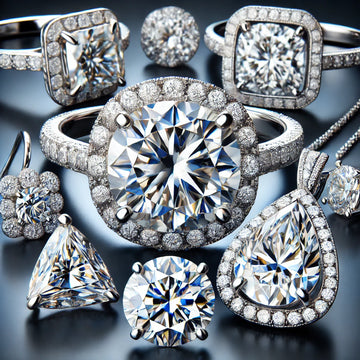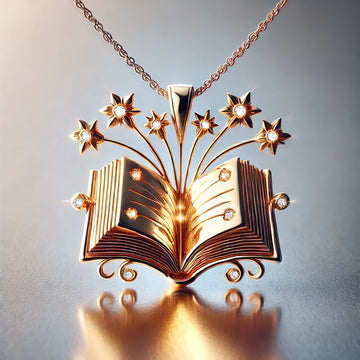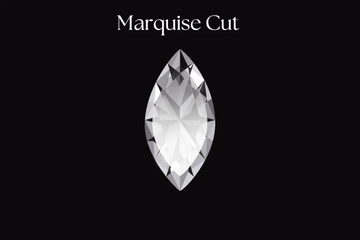Discover the World of Diamonds: Essential Knowledge for Jewelry Lovers
by Keyur Koshiya on Oct 24, 2024

The 4Cs of Diamonds
The 4Cs—Cut, Color, Clarity, and Carat—are the universal standards used to determine the quality and value of a diamond. Each of these characteristics plays a vital role in a diamond’s beauty, and understanding how they interact will help you identify the right balance between quality and price.
1. Cut: The Key to Sparkle
The cut of a diamond is perhaps the most critical of the 4Cs, as it directly impacts how well the diamond interacts with light. A well-cut diamond reflects light from one facet to another, creating the sparkle and brilliance for which diamonds are famous. Conversely, a poorly cut diamond will appear dull, even if it has excellent color and clarity.
- What Is Diamond Cut?
The cut refers not to the diamond’s shape but to how well it has been cut and polished to enhance its reflective qualities. A diamond’s cut is graded based on factors such as symmetry, proportions, and polish. The Gemological Institute of America (GIA) grades diamond cuts as Excellent, Very Good, Good, Fair, or Poor.
- How Cut Affects Brilliance :
When a diamond is cut to the proper proportions, it reflects light in the most efficient manner, maximizing its brilliance and fire (the dispersion of light into a rainbow of colors). A diamond with an excellent cut will appear brighter and more vibrant than one with a poor cut, even if both diamonds have the same color, clarity, and carat weight.
- Cut Proportions :
The proportions of a diamond are crucial in determining how light passes through it. A diamond that is too shallow or too deep will not reflect light optimally, resulting in less brilliance.
- Ideal Cut: These diamonds are proportioned to achieve maximum brilliance and fire. They are rare and highly sought after.
- Shallow Cut : A shallow diamond allows light to escape from the bottom, reducing its brilliance.
- Deep Cut : A deep-cut diamond loses light from the sides, also diminishing its sparkle.
2. Color: Evaluating Diamond Purity
Diamonds are graded on a color scale that ranges from D (completely colorless) to Z (a noticeable yellow or brown tint). Colorless diamonds are the most valuable because they allow more light to pass through, which enhances their brilliance and fire. Most diamonds used in jewelry fall somewhere between colorless and near-colorless.
- Color Grades :
- D-F : Completely colorless diamonds. These are the rarest and most expensive.
- G-J : Near-colorless diamonds. These diamonds may show a slight hint of color, but it is often undetectable to the untrained eye.
- K-M : Diamonds with a faint color. The tint is more noticeable in larger stones but may be less visible in smaller diamonds or diamonds set in yellow gold.
- N-Z : These diamonds have noticeable yellow or brown tints and are generally less valuable.
- The Effect of Color on Value :
The less color a diamond has, the more valuable it is. However, it’s essential to note that the difference between color grades can be subtle. In many cases, choosing a diamond in the G-H range offers excellent value, as the color difference is hard to detect once the diamond is set in jewelry.
3. Clarity: The Presence of Imperfections
Clarity refers to the presence of internal or external imperfections in a diamond. These imperfections, known as inclusions (internal) and blemishes (external), occur naturally during the diamond’s formation process. The fewer inclusions and blemishes a diamond has, the higher its clarity grade and value.
- Clarity Grades:
- Flawless (FL) : No inclusions or blemishes visible under 10x magnification. These diamonds are extremely rare and highly prized.
- Internally Flawless (IF) : No internal inclusions, but may have minor surface blemishes.
- Very Slightly Included (VS1 and VS2) : Diamonds with very minor inclusions that are difficult to see under 10x magnification. These inclusions do not affect the diamond’s appearance to the naked eye.
- Slightly Included (SI1 and SI2) : Diamonds with inclusions that are visible under 10x magnification and may be visible to the naked eye.
- Included (I1, I2, and I3) : Diamonds with inclusions that are visible to the naked eye and may affect the diamond’s brilliance.
- The Importance of Clarity in Everyday Wear :
While flawless diamonds are the most valuable, many diamonds with inclusions are still stunning, especially if the inclusions are small or located in less visible areas. In fact, diamonds in the VS and SI clarity ranges often offer excellent value, as their imperfections are difficult to see without magnification.
4. Carat: The Size of the Diamond
Carat weight measures the size of a diamond. One carat is equivalent to 200 milligrams, and diamonds are weighed to the nearest hundredth of a carat. Larger diamonds are rarer and more valuable, but it’s important to remember that carat weight alone does not determine a diamond’s beauty.
- How Carat Weight Affects Price :
The price of a diamond increases exponentially as carat weight increases. For example, a 2-carat diamond is generally much more expensive than two 1-carat diamonds of the same quality. However, a smaller diamond with an excellent cut may appear more brilliant than a larger diamond with a poor cut.
- Carat Weight vs. Size Appearance :
It’s also important to consider the diamond’s cut, as a well-cut diamond may appear larger than its actual carat weight due to how light reflects through it. The shape of the diamond also plays a role in its perceived size, with certain shapes (like oval or marquise) appearing larger than round diamonds of the same carat weight.
Popular Diamond Shapes
While the 4Cs focus on the quality and value of a diamond, the shape of the diamond is a matter of personal preference. Each diamond shape has its own unique characteristics and appeal. Here are some of the most popular diamond shapes:
1. Round Brilliant Cut
The round brilliant cut is the most popular and classic diamond shape. Known for its exceptional brilliance and fire, this cut features 58 facets that are specifically designed to reflect light and create maximum sparkle. The round shape is versatile and timeless, making it a popular choice for engagement rings and other fine jewelry.
2. Princess Cut
The princess cut is a square or rectangular-shaped diamond with pointed corners. It is the second most popular diamond shape due to its modern, elegant look. The princess cut offers a similar level of brilliance as the round brilliant cut but with a more contemporary aesthetic.
3. Cushion Cut
The cushion cut, sometimes called the "pillow cut," has rounded corners and larger facets that enhance the diamond’s brilliance. This shape has a vintage appeal and is often chosen for its romantic, softer appearance. Cushion-cut diamonds come in square or rectangular shapes and are a popular choice for engagement rings.
4. Emerald Cut
The emerald cut features long, rectangular facets and a large, open table (the flat top of the diamond), which creates a "hall of mirrors" effect. Unlike brilliant-cut diamonds, the emerald cut emphasizes clarity and a diamond’s internal characteristics rather than sparkle. This shape exudes sophistication and elegance, often chosen for its understated beauty.
5. Oval Cut
The oval cut is an elongated version of the round brilliant cut, offering similar brilliance while creating the illusion of a larger stone. The oval shape can also make fingers appear longer and more slender, making it a popular choice for engagement rings.
6. Marquise Cut
The marquise cut is an elongated shape with pointed ends, designed to maximize the diamond’s carat weight. This shape creates a striking, bold look and makes the diamond appear larger than it actually is. The marquise cut is often chosen for its dramatic, regal appearance.
7. Pear Shape
The pear-shaped diamond, also known as the teardrop shape, combines the brilliance of the round cut with the elegance of a marquise shape. It has one rounded end and one pointed end, creating a unique, graceful look. Pear-shaped diamonds are often used in earrings and pendants but are also a beautiful choice for engagement rings.

 Engagement Ring
Engagement Ring  Anniversary Rings
Anniversary Rings Solitaire Rings
Solitaire Rings Halo Rings
Halo Rings Men's Ring
Men's Ring Toi Moi Ring
Toi Moi Ring Three Stone Rings
Three Stone Rings Nature Inspired Rings
Nature Inspired Rings Rose Cut Diamond Rings
Rose Cut Diamond Rings Fancy Color Rings
Fancy Color Rings Antique Cut Diamond Rings
Antique Cut Diamond Rings Wedding rings
Wedding rings All Lab Grown Diamond Ring
All Lab Grown Diamond Ring Engagement Ring
Engagement Ring  Three Stone Rings
Three Stone Rings Daily Wear
Daily Wear Fancy Color Rings
Fancy Color Rings Antique Cut Diamond Rings
Antique Cut Diamond Rings Earrings
Earrings Bracelet
Bracelet Pendent
Pendent Necklace
Necklace Men's Ring
Men's Ring Bridal Sets
Bridal Sets Rings
Rings Earrings
Earrings Tennis chain
Tennis chain Custom Pendent
Custom Pendent Custom Ring
Custom Ring Custom Teeth Grillz
Custom Teeth Grillz Round
Round Oval
Oval Cushion
Cushion Marquise
Marquise Pear
Pear Emerald
Emerald Heart
Heart Princess
Princess Rose Cut
Rose Cut Radiant
Radiant Antique Cut
Antique Cut


